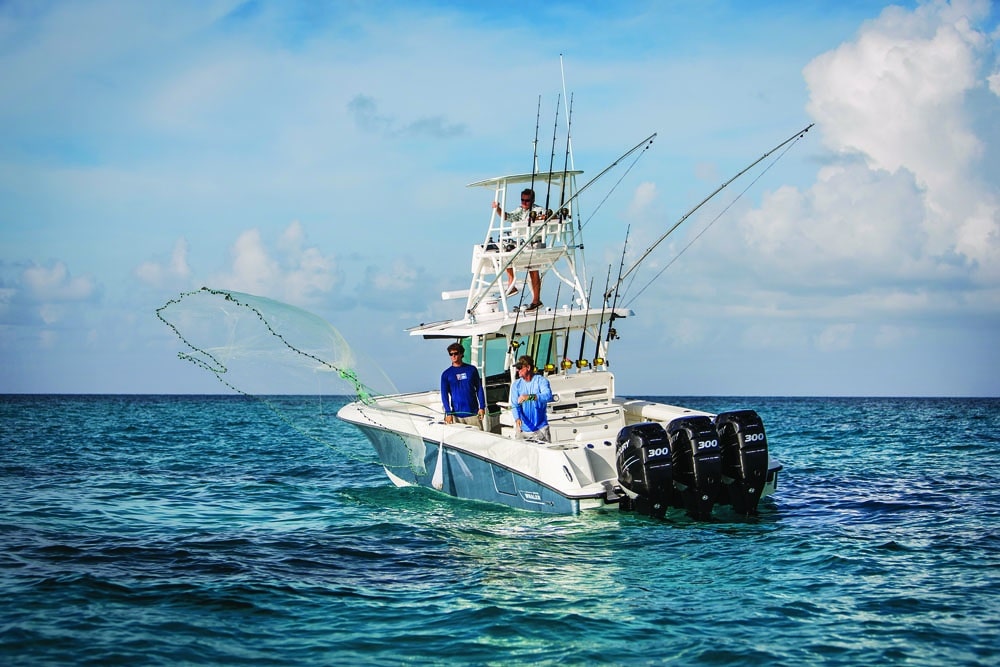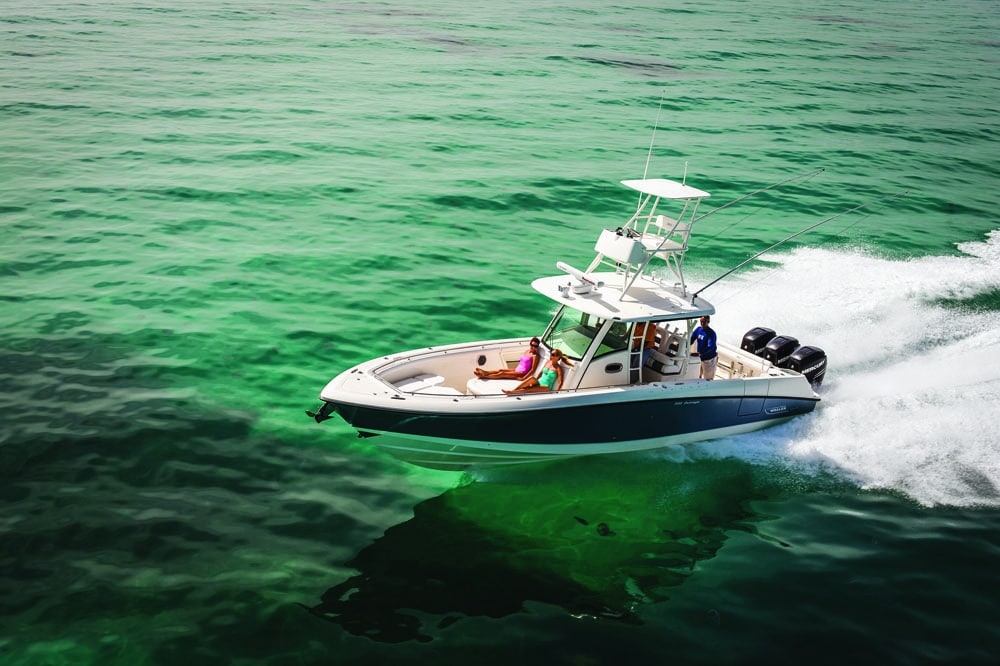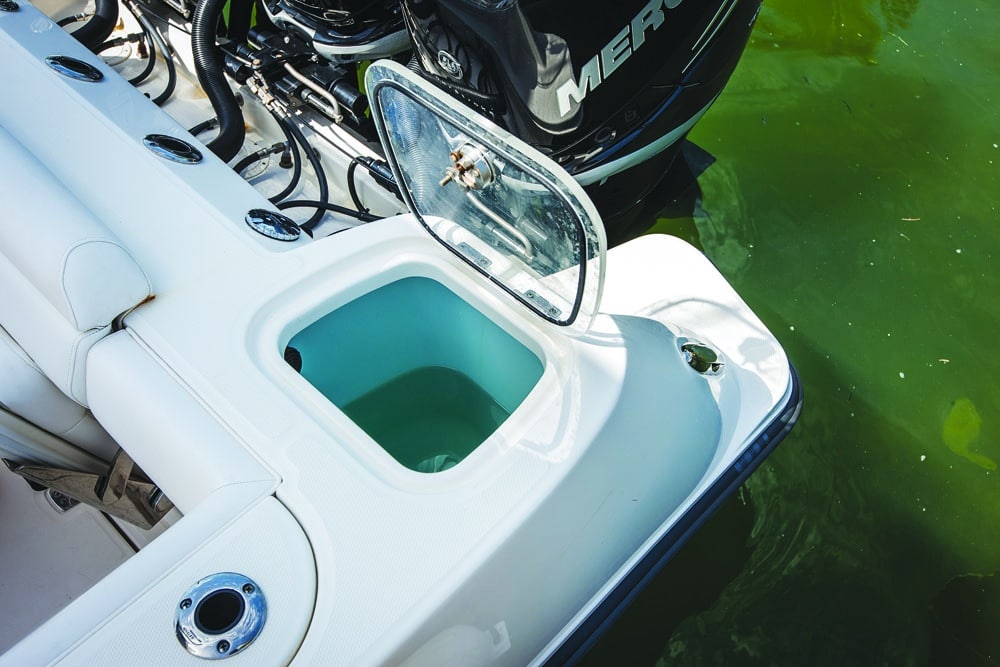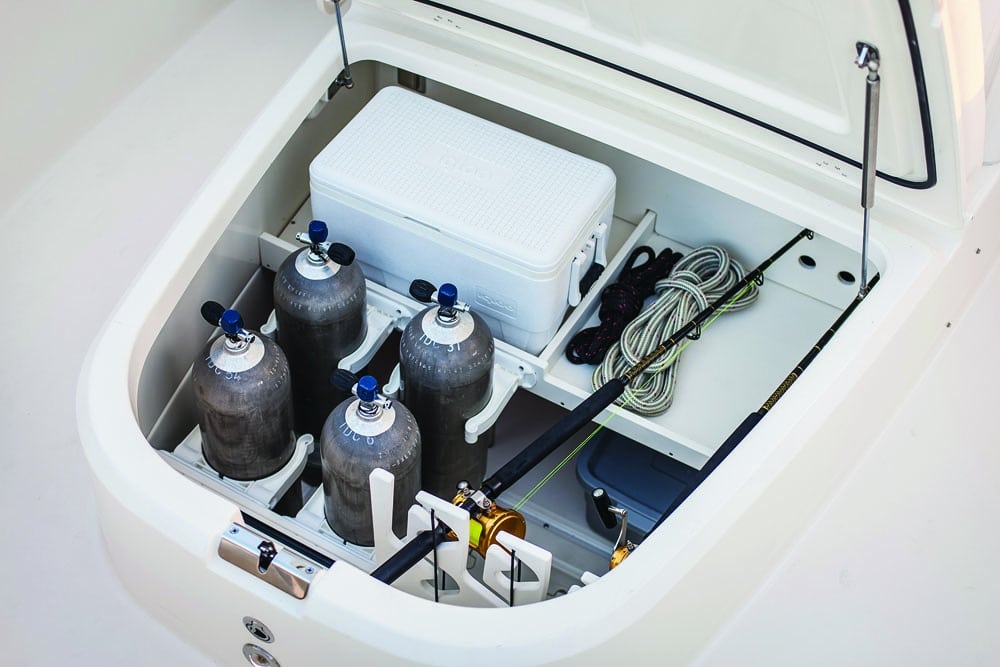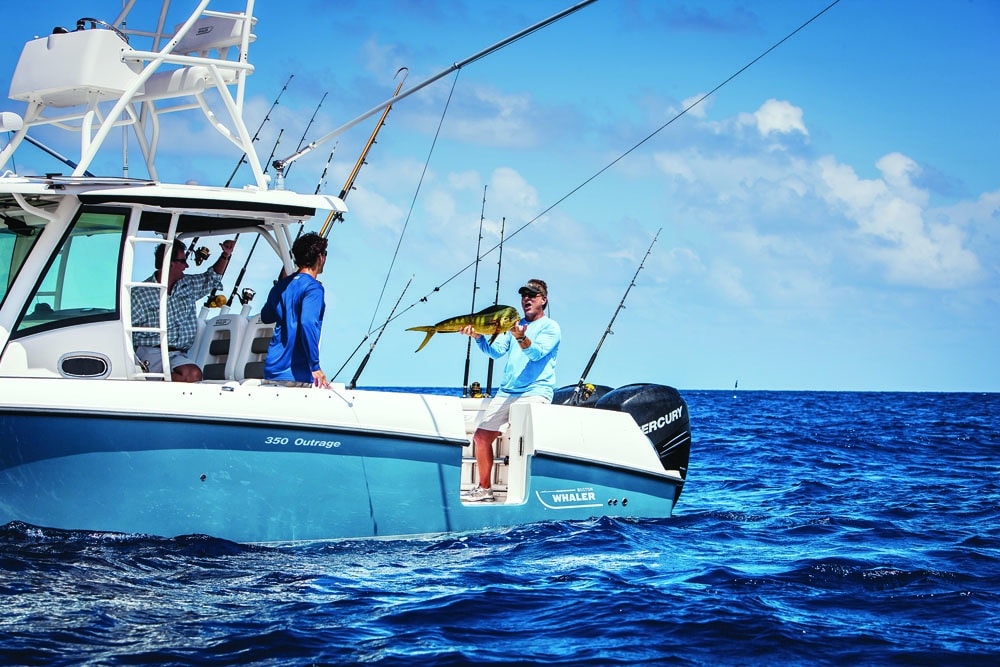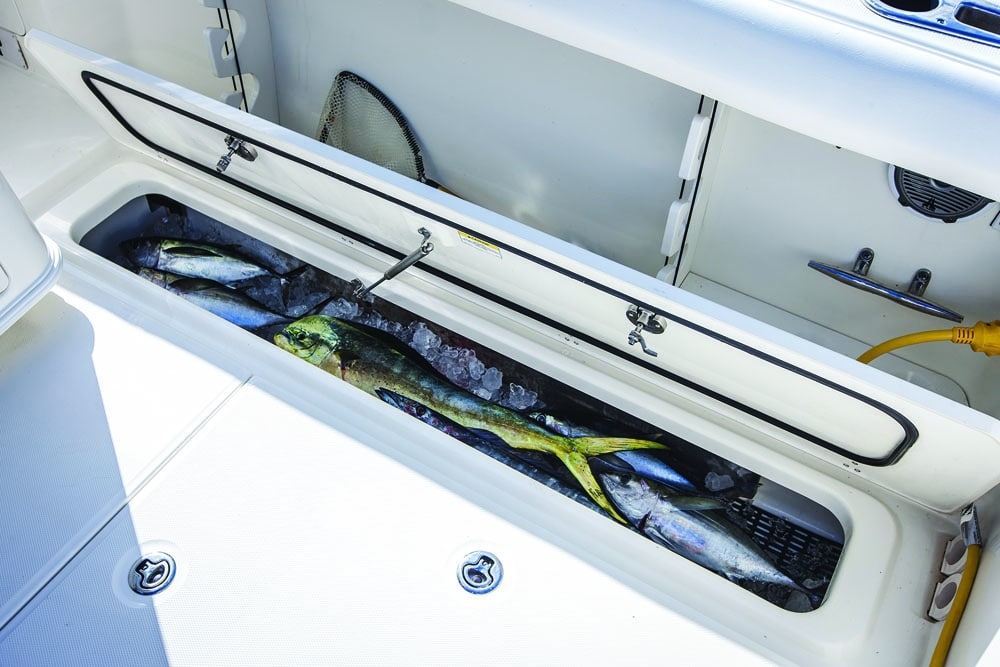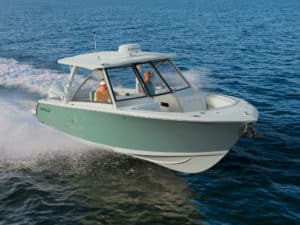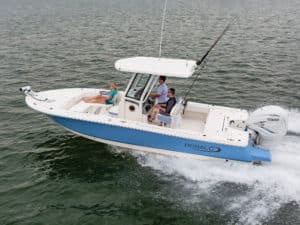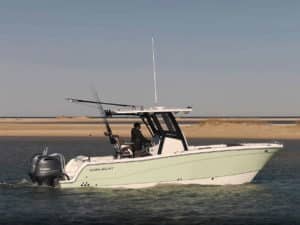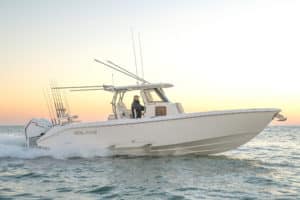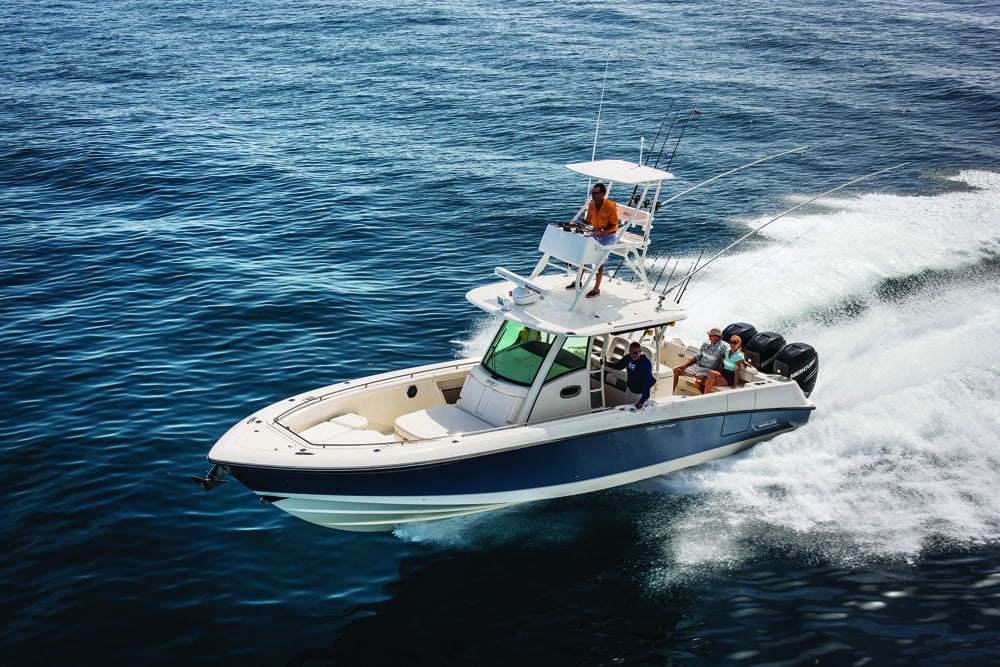
Boston Whaler 350 Outrage
Despite the dire weather predictions in early January, captains Wil Rogers and Brandon Jimenez brimmed with exuberance as we boarded the new Boston Whaler 350 Outrage. Our goal: Test the mettle of the 350 Outrage center-console in the course of pursuing sailfish off north Key Largo, Florida. Wrought by the infamous Polar Vortex, the offshore forecast called for 35 knots, 6-foot seas and air temperatures in the mid-50s — not exactly a chamber-of-commerce day.
“This is what sailfish like,” said Rogers, large-boat business manager for Whaler. “And we have the right boat to get the job done.” With his expression of confidence, I shook off any trepidation, if not the wind chill.
As Rogers pulled the 35½-footer away from the dock, using the optional Mercury Joystick Piloting system, I climbed inside the console, and donned an extra layer and my foul-weather gear, while at the same time checked out the amenities: a shower, VacuFlush toilet, hanging locker, storage cabinet, and vanity with a sink and mirror.
Whaler has staked its reputation on building unsinkable boats ranging up to 37½ feet in length. While the 350 is not the largest center-console in the fleet, it’s one of the fishiest. “This boat’s big sister, the 370 Outrage, is loaded with creature comforts and accessories,” Rogers explained. “Yet the 350 is designed more for the angler who wants to shoot out to fish for a day or less, and then come back to the marina. You can order all the options you want, but in its basic configuration, it’s more of a pure fishing machine.”
Our boat bristled with fishing rods loaded into two distinct racks — one for seven sticks just aft of the helm seating and a second for five rods in the transom bulkhead. That’s not counting the eight gunwale rod holders, under-gunwale storage for six sticks, and storage for another six rods as part of the watertight mini coffin box built into the forward section of the center console. When the box is closed, you find a padded lounger for two on top with fold-down armrests.
Charging Ahead
I got an early taste of the 350’s seakeeping ability as we ran up-sea en route to our first stop to catch ballyhoo. The inner waters were heaping into 2- to 3-foot waves, and Rogers pushed the triple 300 hp Mercury Verado outboards to 4,000 rpm, where the 350 easily bridged the peaks. We loped along at a comfortable and dry 34 mph.
Triple 300 Verados represent the most popular power configuration for the Whaler 350 Outrage, according to Rogers. “We have some customers who want 250 Verados, but most want the triple 300s,” he explained as we neared the reef outside north Key Largo.
The seas built to 4 feet on top of the reef, where mooring buoys allowed us to tie up while fishing for bait, negating the need to anchor. The windlass is hidden under the bow hatch and the anchor rests in a roller recessed into the bow stem, resulting in a streamlined foredeck that eases the task of hooking the buoy line and bridling it to a pair of pull-up cleats on the bow. Once we were set up, Jimenez put out the chum bag and fished pieces of shrimp on small hooks with bobbers for ballyhoo while waiting for the bait to school.
With the stern bench seat folded away, the back of the outboards lay only about 6 feet from the transom, making it relatively easy to reach over the engines with our light 7-foot rods. Within 10 minutes, the ballyhoo balled up tight behind the boat. The 350’s spacious aft cockpit gave Jimenez plenty of room to wind up and throw the 10-foot net over the transom.
He needed only two tosses to fill the pressurized 40-gallon livewell that’s built into the elaborate rigging station aft of the helm seats. The boat features a second 23-gallon livewell in the port quarter, but the central tank held more than enough bait for our trip.
Rigged for Success
The optional aluminum outriggers ($2,813) easily deployed with the locking handles on the underside of the 350’s standard hardtop as we set up to slow-troll live ballyhoo. We worked east across the current with all three Verados turning about 550 rpm, giving us a 1.2 mph trolling speed. By now the seas were up to 5 feet at five seconds apart, yet the 350 proved a very a stable platform, whether idling up-sea, in the trough or down-sea. Jimenez put out four baits — two in the outriggers and two on flat lines.
My test boat lacked the optional tower station, so Rogers piloted from the comfort of the console helm, which has the wheel for the Verado power-steering system mounted in the center, with the control box for the Mercury DTS system to starboard. The integral tempered-glass enclosure helped keep him and the optional twin Raymarine 15.4-inch e Series touch-screen displays dry from any wind-driven spray. These were interfaced with an optional Raymarine 1 kW, dual-frequency fish finder and 4 kW high-definition radar with an open-array antenna ($33,639 for the electronics package).
Centrally flush-mounted at the huge dash panel was a standard Mercury VesselView 7 touch-screen display, for monitoring the engines and other systems. I really like the positioning of the twin rocker-switch panels — just slightly below eye level and easy to reach. We used the switch for the standard windshield wiper countless times.
The Mercury Joystick Piloting system ($27,664) includes autopilot and Skyhook, allowing you to hold your position using GPS as reference, even with waves and current trying push the boat along. The control for these systems was mounted just to the starboard side of the wheel.
The console seating accommodates passengers on either side of the captain. Fold-down armrests and a built-in footrest in the console add comfort, but on this rough day, we chose to stand, using the flip-up bolsters as leaning posts. We also used the fold-down “visibility step,” which adds about 6 inches of extra elevation when standing at the helm — great for shorter anglers and for getting a little better view of the water.
Fish On
As we reached a depth of 150 feet, a 12-pound mahimahi crashed the port flat line, and Jimenez wound tight to plant the 6/0 circle hook. Coaming bolsters encircling the interior (except for the transom door) cushioned his thighs as he fought the acrobatic fish from the stern. I quickly extracted an 8-foot gaff from under the starboard gunwale and handed it to Jimenez, who gaffed the fish himself. We iced the mahi in one of the two overboard-draining fish lockers that flank the aft cockpit sole.
Bird activity told us we had found a life zone, yet by now the weather had deteriorated even further. Gusting winds blew the caps off the growing waves, leaving long streaks of foam across the menacing seas. Yet Rogers was determined to stick it out. “We’re going to catch a sailfish before we head home,” he exclaimed. His confidence proved well founded.
Not long after putting the baits out again, a group of -sailfish attacked the spread. The first bite came on the starboard rigger. Rogers asked me to take over the helm as he swung into action and began clearing lines while Jimenez fought the sail. As luck would have it, the fish spit the hook. Yet the crew’s disappointment quickly evaporated when a second sail bit the port flat line. Rogers dropped back, and then came tight as the fish streaked astern.
Run-and-Gun
Jimenez grabbed the helm and accelerated the 350 into a 180-degree turn to chase the fish up-sea as Rogers made his way to the bow. In these conditions, he chose to stay off the elevated bow platform, instead bracing himself between it and the forward portion of the console while fighting the sail. Within 10 minutes, the sail was boat-side, uncorking some spectacular jumps before its release.
With one sail to our credit, Rogers began trolling toward home but soon spied a frigate bird in the distance, dipping over a showering school of bait. We quickly brought in the lines as Rogers accelerated to 5,000 rpm and 46 mph to -intercept the action. As we slid into the frenzy, Jimenez stepped up on the elevated bow platform, which made it easy to cast a live ballyhoo to the breaking fish. He was bit -immediately. While we were all hoping for another sail, this fish was a big bonito.
As Jimenez released the fish, we all agreed it was time to run for home. While many anglers considered the day unfishable, the new Boston Whaler 350 Outrage — in the hands of an experienced and unflappable crew — proved that you can score, even in the face of the Polar Vortex.
PERFORMANCE
LOAD: 202 gallons of fuel, three adults, fishing gear
TOP SPEED: 57.1 mph
TIME TO 30 MPH: 10.1 sec.
BEST MPG: 1.08 @ 34.3 mph (4,000 rpm)
HULL
LOA: 35 ft. 6 in.
BEAM: 10 ft. 10 in.
DEADRISE: 23 deg.
WEIGHT: 11,000 lb. (dry)
FUEL: 400 gal.
MAX POWER: 1,050 hp
MSRP AS TESTED: $427,111*
*(w/ triple Mercury 300 Verados, options)
Boston Whaler
Edgewater, Florida
877-294-5645
